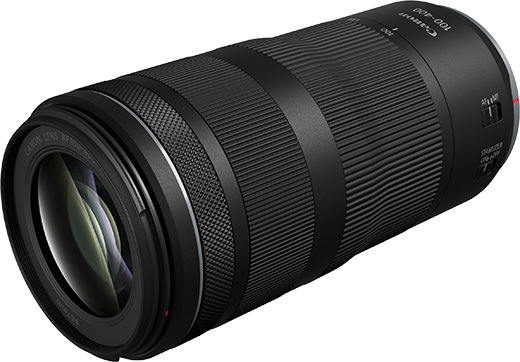- Specifications
- Block diagram
| Marketed | October 2021 |
| Original Price | Open price |
| Lens Construction (group) | 9 |
| Lens Construction (element) | 12 |
| No. of Diaphragm Blades | 9 |
| Minimum Aperture | 32 (at 100mm), 45 (at 400mm) |
| Closest Focusing Distance (m) | 0.88 (at 200mm) |
| Maximum Magnification (x) | 0.41 (at 400mm) |
| Filter Diameter (mm) | 67 |
| Maximum Diameter x Length (mm) | Approx. 79.5×164.7 |
| Weight (g) | Approx. 635 |
Measuring approximately 164.7 mm in length and weighing approximately 635 g, the new lens features an optical design that incorporates 12 elements in 9 groups, including one UD (Ultra Low Dispersion) lens and one aspherical lens. This helps mitigate chromatic aberrations across the entire zoom range and makes possible clear photos with minimal color fringing. Compared with the attractively priced and beloved EF 70-300mm f/4-5.6 IS II USM (released in December 2016), the RF100-400mm F5.6-8 IS USM features an extra 100 mm focal length range on the telephoto end. This extra reach helps meet the needs of photographers shooting subjects including people on stage or on the sports field, or animals that are difficult to approach, by making subjects appear larger.
The RF100-400mm F5.6-8 IS USM also utilizes Canon’s proprietary Nano USM, an ultrasonic motor that provides high-speed, high-accuracy AF when capturing video. In addition, when used alongside the EOS R5 (released in July 2020), AF covers approximately 100% (H) and 100% (W)1 of the distance measurement area across the entire zoom range.
When attached to the EOS R5 the lens’ image stabilization (IS) works together with the EOS R5’s in-body image stabilization to deliver up to 6.0 stops2 of image stabilization. When paired with the EOS R (released in October 2018), the lens achieves up to 5.5 stops2 of IS. The lens also realizes a maximum magnification of 0.41x (at a focal length of 400 mm) and a minimum focusing distance of 0.88 m (at a focal length of 200 mm) allowing users to enjoy close-up photography of subjects such as flowers.
1 With “Face+Tracking” enabled and subject frame displayed. May not be supported during certain scenarios or due to certain conditions related to the subject.
2 Based on CIPA standards. Focal length of 400 mm. Yaw/Pitch axes.

UD lenses Aspherical lens IS unit


